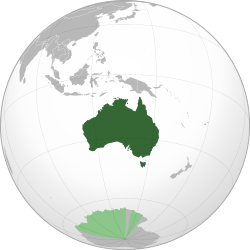US Naval Base Australia | |
|---|---|
 Australia in the South Pacific in dark green | |
| Largest city | Sydney Naval Bases 1941–1945 |

U.S. Naval Base Australia comprised several United States Navy bases in Australia during World War II. Australia entered World War II on 3 September 1939, being a self-governing nation within the British Empire. The United States formally entered the war on 7 December 1941 after the Japanese attack on Pearl Harbor. Following this attack Japanese forces quickly took over much of the western and central Pacific Ocean. The United States lost key naval bases including Naval Base Manila and Naval Base Subic Bay as a result of the 1941 Japanese invasion of the Philippines, along with Guam and Wake Island. The Allied forces needed new bases in the South West Pacific to stage attacks on Japan's southern empire, and these were built in Australia. [1]
















